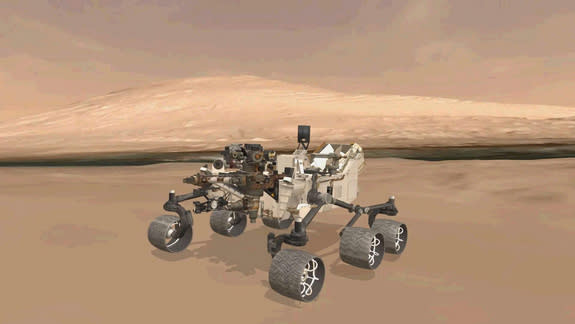NASA decision time: more Mars or go beyond?
NASA is expecting to make two large funding commitments in the next two weeks, which may include another surface mission to Mars to build upon what the rover Curiosity has begun.
One of these commitments will deal with the American space agency's strategic direction for Mars.
For the other, there are three options on the table, according to Edward Weiler, NASA's former head of missions, who quit the agency a year ago in a protest against planned budget cuts.
These options include a trip to Titan (Saturn's largest moon), a visit to a comet or another surface mission to Mars where a lander would drill into the Martian core to determine how planets were formed.
While the rover Curiosity has captured the world's imagination, Mars is not the only planet on the bucket list for scientists to visit.
"There's a lot to learn in the solar system," Weiler said in an interview with CBC News. "The solar system has lots of neat stuff."
At this juncture in U.S. space history, dedicated funding for surface expeditions besides Mars is uncertain.
But Weiler and other scientists want to see space exploration move beyond the red planet.
Some scientists want to fly past Mars and head straight for Titan, one of the few galactic bodies besides Earth to have what is called a true atmosphere, including gases, water and ice.
"It's a moon but it's a world," said Jonathan McDowell, an astrophysicist who works with NASA hunting for black holes.
Thanks to the Cassini-Huygens orbiter, launched in 1997, the world got to see for the first time that this moon is actually made of continents of ice and vast lakes of methane.
"That's the place that looks like a world kind of like Earth, rather than a rock spinning in space," McDowell said.
But the orbiter wasn't able to determine whether these lakes had any traces of life swimming in them, which is why NASA scientists are proposing a project called the Titan Saturn Mission.
It would send a space vehicle to the moon and drop a boat into the lake to analyze the organic makeup of the water.
While this project is still in the proposal stages, NASA is expected to make a big announcement about whether it will get the green light in the next two weeks.
That's if it beats out an additional surface expedition to Mars and a comet mission, which are all in competition.
Another place in the solar system that might be worth visiting is Europa, one of Jupiter's many moons.
Unlike other rocks in the solar system, the surface of Europa is covered with water.
"Probably what you want there is not so much like a rover but a submarine," said McDowell.
But first any mission exploring this ocean would need to penetrate a thick sheet of ice that covers the planet.
Even closer is a trip to Venus. But although this planet is much warmer than other options, average temperatures on Venus could range from 600 C to 800 C.
"It's really a ratty place to go, but it's our twin," said Weiler. "Venus is almost the same size of the Earth. It's the closest planet. You know, your neighbour."
Several missions have been attempted already by NASA and Russia but not with the greatest success.
NASA's New Frontiers Program proposed another mission to Venus in 2009. But the mission called the Surface and Atmosphere Geochemical Explorer (SAGE) was later canned.
A number of scientists and even businesses want to see the next major surface space expedition go to an asteroid.
One of those asteroid-bound businesses is Planetary Resources and its goal is to not only send a spacecraft to one of these drifting rocks but also to mine it and make money.
In 10 years, this company would like to have a small spacecraft on the surface of an asteroid scooping up soil into an onboard processor. The processor would then extract water and refine the precious metals on the surface and concentrate these metals.
"And the next step beyond that would be actually using that material and selling that to a customer," said Tom Jones, an adviser to Seattle-based Planetary Resources.
Jones is a former NASA astronaut and he would like to see more surface space expeditions go beyond the pure scientific focus.
"Not just with cameras and with elemental or mineral analysis but I will like to see us manipulating the surface material," Jones said. "And extracting resources."
Jones said it's unlikely NASA would be able to foot the bill for missions like this.
That's why Planetary Resources is exploring partnerships with private companies, especially mining companies that have experience working with robots in some of the most hostile conditions on Earth.
But before robots can even land on an asteroid they need to get there.
Right now, Planetary Resources is in the process of developing a spacecraft that will get to an asteroid's surface and back. Only two spaceships have ever landed on an asteroid.
"So that is a challenge that needs to be taken on," Jones said.



